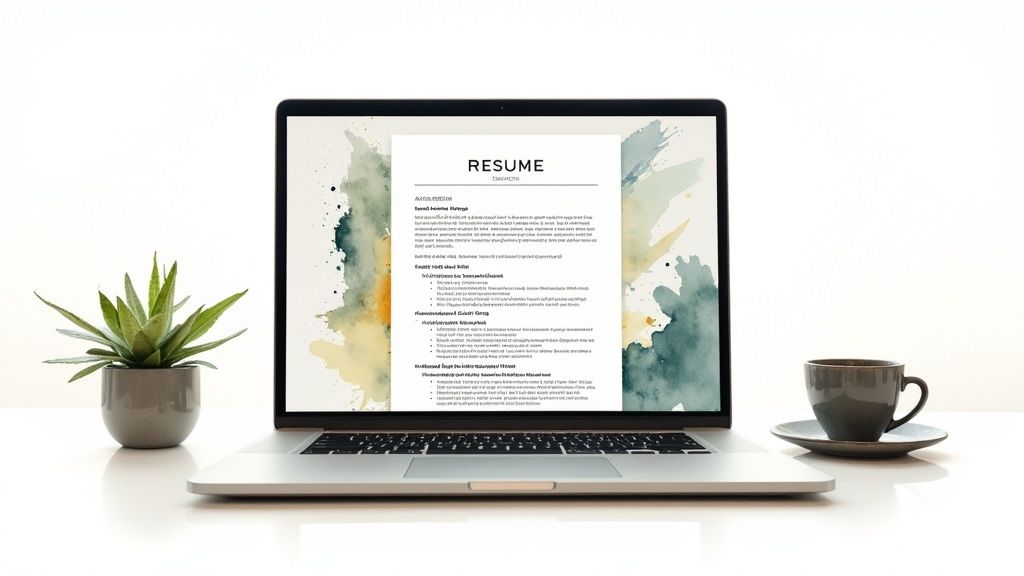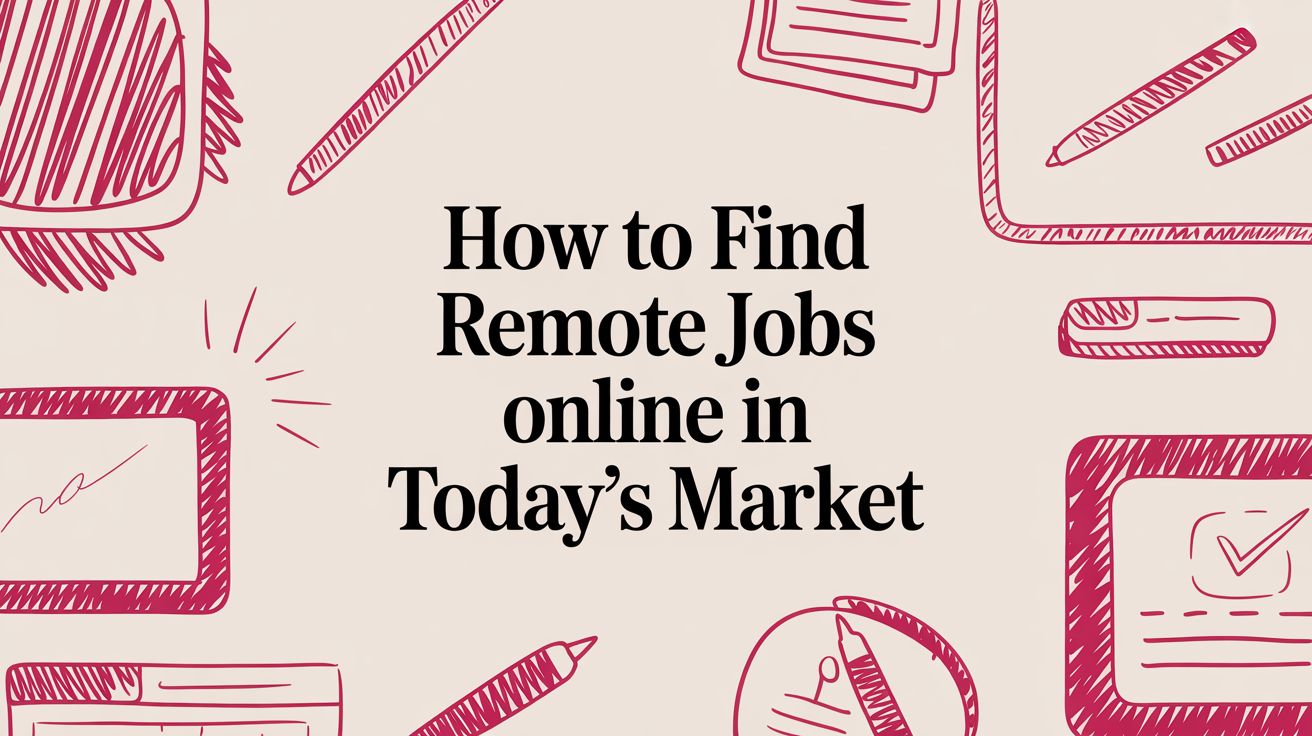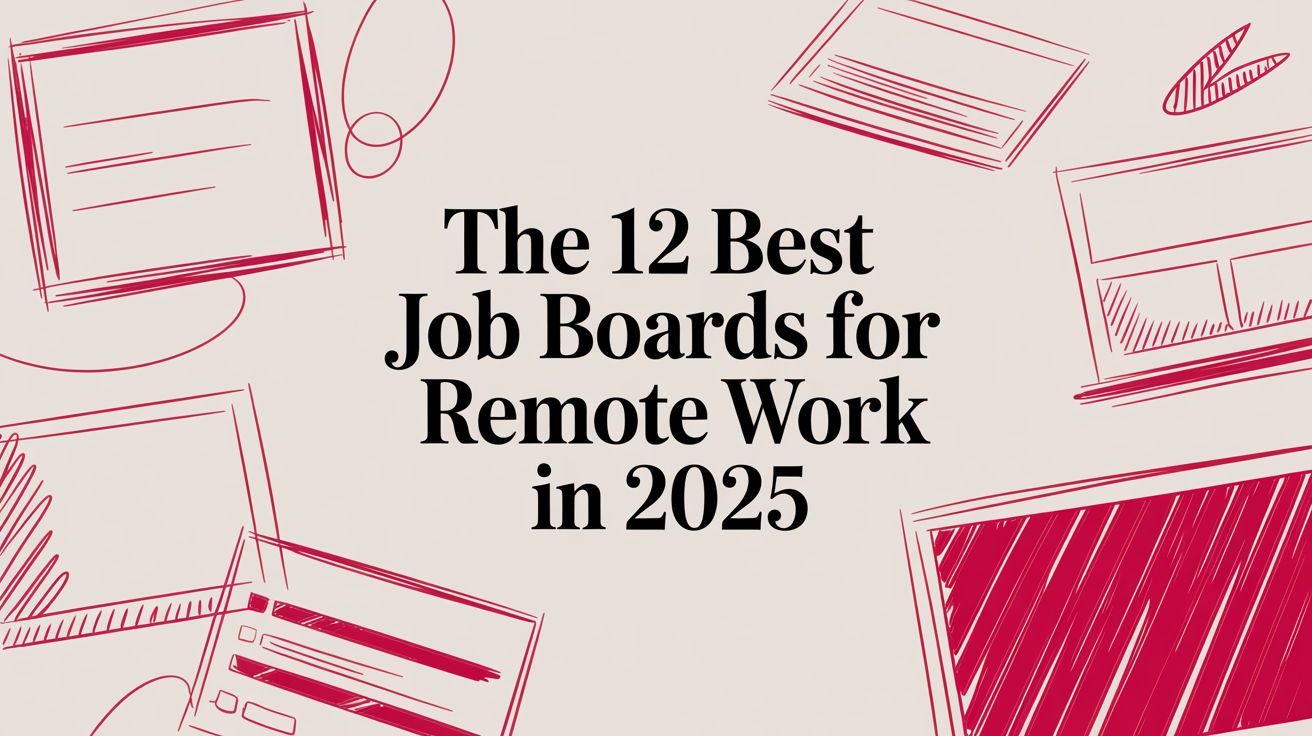Finding a great remote job isn’t about luck. It’s about having a smart, targeted strategy.
You need to do more than just blast out applications. The real key is to build a remote-ready brand, zero in on the right job platforms, and network like you mean it. This is how you stop being just another applicant and become the candidate they have to hire.
Thriving in the Modern Remote Job Market
Let’s get one thing straight: landing a top-tier remote job is a game of strategy, not chance. You have to position yourself as someone who doesn’t just want to work remotely, but who is built to excel in a distributed team. It’s about showing employers you have the autonomy and communication skills they desperately need.
The demand for skilled remote professionals is still incredibly high, but so is the competition. The worldwide shift to remote work wasn’t a phase; it’s a fundamental change in how we work. As of August 2024, around 22.8% of US employees—that’s about 35.1 million people—were working remotely at least some of the time.
This means companies are definitely hiring, but they can afford to be picky. On platforms like LinkedIn, a staggering 60% of all job applications were for remote or hybrid positions, even though those roles made up only 20% of the jobs posted. The numbers don’t lie—you need an edge.
Focus on Remote-First Industries
Your first move should be to focus your energy where it counts: on industries that have truly gone all-in on remote work. Don’t waste your time trying to convince a company that’s still on the fence. Go where remote is the default, not the exception.
A few of the hottest sectors right now include:
- Technology: This is the undisputed leader. Roles in software development, cybersecurity, and data analysis are almost expected to be remote.
- Professional Services: Fields like marketing, finance, consulting, and customer support have made a seamless transition to remote-first operations.
- Creative and Media: If you’re a writer, designer, or video editor, your work is often naturally location-independent.
By targeting these areas, you’re fishing in a well-stocked pond. These companies already have the tools, processes, and culture to support a thriving remote team. To dig deeper into why this model works so well, check out the benefits of remote work in our detailed guide.
To give you a clearer picture, here’s a breakdown of industries where you’ll find the highest concentration of remote opportunities.
Top Industries for Remote Work
| Industry | Percentage of Remote Roles | Key Skills in Demand |
|---|---|---|
| Technology/IT | 45% | Software Development, Cloud Computing, Cybersecurity |
| Marketing | 35% | SEO/SEM, Content Strategy, Digital Marketing |
| Professional Services | 30% | Project Management, Financial Analysis, Consulting |
| Customer Service | 28% | CRM Software, Communication, Problem-Solving |
| Healthcare | 22% | Telehealth, Medical Coding, Healthcare IT |
This table should help you narrow your search and focus on the skills that are most valuable in today’s remote-first landscape.
The Three Pillars of a Successful Search
A truly effective remote job search stands on three core pillars. If you can master these, you’ll rise above the noise and land a role that genuinely fits your life and career ambitions.
The goal isn’t just to find any remote job; it’s to find the right one. This requires a proactive approach that showcases your ability to excel without direct supervision, communicate effectively across time zones, and contribute meaningfully to a company’s culture from a distance.
First, you have to build a personal brand that screams competence and autonomy. Second, you need to become an expert at navigating the right job platforms, not just the biggest ones. And finally, you have to network intelligently in a digital-first world to build connections that actually open doors.
The rest of this guide will walk you through exactly how to execute on each of these pillars, turning your search from a frustrating chore into a calculated and successful campaign.
Building Your Remote-Ready Professional Brand

Before you even dream of hitting that “apply” button, your online presence has to do the heavy lifting for you. It needs to shout from the rooftops that you’re a top-tier remote candidate, not just someone hoping to ditch their commute. This is about more than just a quick LinkedIn refresh—it’s about strategically building a professional brand that screams competence, autonomy, and remote-readiness.
Think of your resume and professional profiles as your personal marketing campaign. They need to be meticulously crafted to spotlight the skills remote employers really care about. I’m not just talking about your technical chops; I’m talking about the soft skills that make distributed teams actually work.
A remote hiring manager isn’t just asking, “Can this person do the job?” They’re asking, “Can this person do the job without someone looking over their shoulder?” Your brand needs to answer that second question with a resounding “yes.”
This means you have to change your language. Don’t just list what you did. You need to reframe your accomplishments to show how you did them in a way that proves you thrive without hand-holding. This is a game-changing shift when you’re figuring out https://remotefirstjobs.com/blog/how-to-find-remote-work that’s a perfect match.
From On-Site Accomplishments to Remote-Ready Proof
Translating your in-office experience into remote-friendly language is an art. It’s all about connecting your past wins to the core skills that make remote work successful. Let’s break down a real-world example of what this looks like.
Before:
- “Led a cross-departmental project to launch a new product feature.”
This is okay, but it’s vague. It tells me nothing about how you led. For all I know, you did it through daily in-person huddles and a giant whiteboard.
After:
- “Spearheaded a cross-departmental project to launch a new product feature, coordinating efforts across three teams using asynchronous communication channels like Asana and Slack. Delivered the project 10% ahead of schedule with minimal direct supervision.”
See the difference? The “after” version is packed with proof. It immediately shows you can manage projects on your own and that you’re already fluent in the tools of the trade.
Here are a few key skills you should be weaving into your resume and profiles right now:
- Asynchronous Communication: Mention specific tools like Slack, Notion, or Microsoft Teams and give an example of how you used them to keep things moving.
- Project Autonomy: Point to times you ran with a task or a whole project with a high degree of independence.
- Proactive Problem-Solving: Share a story about a time you spotted a problem and fixed it before anyone asked you to.
- Time Management: Use numbers to show how you crushed deadlines or juggled competing priorities in a busy environment.
Create a Portfolio to Showcase Your Work
Portfolios aren’t just for designers and writers anymore. Seriously. Putting together a simple, professional portfolio is one of the most powerful ways to show, not just tell, what you can do. It gives a hiring manager who has never met you tangible proof of your skills and work ethic.
Your portfolio can be a clean, simple website or even a polished PDF. What goes inside?
- Project Managers: Show off project plans, timelines you’ve crushed, or case studies of successful initiatives.
- Marketers: Display campaign results, great copy you’ve written, or charts showing social media growth.
- Customer Support Specialists: Include anonymized screenshots of stellar customer interactions or a brief write-up on how you improved a support workflow.
This kind of visual evidence makes your skills feel real. And beyond just the resume, learning how to build a compelling personal brand will put you miles ahead of the competition. It proves you’re a self-starter who takes immense pride in their work. For more on this, our complete guide on how to find remote work dives even deeper. This proactive branding is what separates the casual job seeker from the can’t-miss candidate.
Finding Gold in the Right Job Platforms

Wasting hours scrolling through generic job boards is a fast track to burnout. I’ve seen it happen countless times. The real secret to an effective remote job search isn’t about being everywhere at once; it’s about being in the right places.
Think of it like a strategic expedition. You wouldn’t look for gold in a sandbox, so why look for a high-quality remote role on a platform that doesn’t really care about them?
The remote job world can feel huge and overwhelming, but you can navigate it with the right map. From my experience, success comes from a three-part strategy: master the big platforms, explore remote-first niche sites, and tap into the hidden job market. Each one requires a slightly different approach, but together, they form a search strategy that actually works.
Master the Major Job Boards
Giants like LinkedIn and Indeed are popular for a reason—they have a staggering number of listings. But this is both a blessing and a curse. The real challenge is cutting through the noise: the “remote-friendly” jobs that are actually hybrid, or the “fully remote” roles that secretly require you to live in a specific, often expensive, city.
Your first move is to become a pro with their advanced search filters. Don’t just type “remote” and hit enter. You have to dig deeper.
- Get Specific with Location: Use terms like “Remote (Worldwide)” or filter by country to weed out roles tied to a specific city or state.
- Use Keyword Modifiers: Combine your desired role (“Senior Product Designer”) with specific remote terms like “fully distributed,” “location-independent,” or “asynchronous.”
- Set Up Alerts: Once you find a search query that yields good results, save it. Set up daily email alerts so the right opportunities land in your inbox. This automates the most boring part of the job hunt.
Think of it as setting a smart trap. Instead of hunting every single day, you build a system that catches exactly what you’re looking for, saving you a ton of time and energy.
A common mistake is treating all remote job boards the same. A mass-market site requires you to be a filtering expert, while a niche site requires you to be a standout applicant among a smaller, highly qualified pool. Adjust your strategy accordingly.
Uncover Gems on Niche Remote-First Sites
While the big platforms have volume, niche remote-first job boards offer quality and intent. These sites are built from the ground up for the remote work community. Companies posting here aren’t just dabbling in remote work; they’ve fully embraced it as part of their culture. This means less confusion about policies and a much higher signal-to-noise ratio.
Sites like We Work Remotely, Remotive, and our own Remote First Jobs curate listings from companies that are genuinely remote-first. The competition can be tough, but you know every single role you see is the real deal.
To stand out on these platforms, your application has to be on point. Because the applicant pool is often smaller but more experienced in remote work, that professional brand we talked about earlier becomes absolutely critical.
This is truly where you’ll discover the best way to find remote jobs that align with your skills and what you’re looking for.
Remote Job Platform Comparison
Deciding where to invest your time can be tough. This table breaks down the main types of platforms to help you focus your search.
| Platform | Best For (Industry/Role) | Key Feature | Competition Level |
|---|---|---|---|
| LinkedIn, Indeed | Broad range of roles across all industries | Massive volume and powerful networking tools | Very High |
| We Work Remotely, Remotive | Tech, marketing, and creative roles | Curated, high-quality, fully remote listings | High (among specialists) |
| Slack/Discord Communities | Highly specific, specialized roles | Access to unlisted “hidden” opportunities | Low to Moderate |
Each platform has its place, and a smart strategy uses a mix of all three. Don’t put all your eggs in one basket.
Tap into the Hidden Job Market
Some of the best remote jobs are never posted on a public job board. Seriously. They get filled through referrals, personal connections, and online communities. This “hidden job market” lives in the specialized online spaces where pros in your field hang out.
These can be:
- Industry-specific Slack and Discord channels
- Professional forums and subreddits
- Niche online groups centered around a specific technology or skill
To tap into this goldmine, your goal isn’t to show up and immediately ask for a job. That’s a huge turn-off. Your mission is to build credibility. Join conversations, offer helpful advice, and share what you know. Become a known, respected voice in that community.
When a manager in that group has a new opening, they’ll often post it there first to get trusted recommendations. By being an active, helpful member, you put yourself in the perfect position to be the first person they think of.
Networking Remotely to Unlock Hidden Opportunities

Let’s be honest: the best remote jobs often have a secret handshake. They get filled through referrals and quiet connections long before they ever hit a public job board. If your search is limited to just firing off applications online, you’re missing out on a huge slice of the pie.
The real game-changer is learning how to build meaningful relationships right from your desk. This isn’t about sending spammy connection requests or setting up awkward virtual coffees. It’s about strategically getting on the radar of the right people at the right companies.
Think of it as building a network of advocates. These are the people who will think of you the second a relevant role opens up, sometimes letting you skip the application queue entirely.
And this strategy has never been more critical. While the number of remote job postings has ebbed and flowed, applicant interest has stayed sky-high. In fact, remote and hybrid roles pull in a staggering 60% of all job applications. That’s some seriously fierce competition.
This intense demand is exactly why networking is your superpower. It gives you a back door to opportunities that companies don’t even advertise because they don’t want to get flooded. You can get more familiar with the data behind these remote and hybrid work insights to understand the full picture.
Crafting LinkedIn Requests That Actually Get a Response
First things first, you need to identify people who can actually influence hiring. We’re talking hiring managers, team leads, and even current employees in the departments you’re targeting at remote-first companies.
Once you have a list, the real work starts. A generic “I’d like to connect” request is the fastest way to get ignored. Personalization is everything. Your goal is to show you’ve done your homework and are genuinely interested in them and their work, not just in what they can do for you.
Here’s a simple, non-pushy formula I’ve seen work time and time again:
- Find Common Ground: Mention something specific, like a recent post they shared, a project they worked on, or a mutual connection.
- Give a Sincere Compliment: Briefly praise their company’s work, culture, or a specific achievement.
- Make a Soft “Ask” (That Isn’t for a Job): Frame it as a desire to learn or follow their work.
Here’s what that looks like in action:
“Hi [Name], I saw your recent post on [Topic] and was really impressed by your team’s approach at [Company Name]. I’m a [Your Role] who’s passionate about the remote-first culture you’re building. I’d love to connect and follow your work.”
See how that feels? It’s respectful and positions you as an interested peer, not just another job seeker with their hand out.
From Connection to Rapport: Play the Long Game
Once someone accepts your request, resist the urge to immediately pitch yourself or ask about jobs. The goal is to nurture that connection and transition from being a random name to a familiar face.
This is all about consistent, low-effort engagement.
- Comment thoughtfully: Go beyond “great post!” and add your own perspective to their content.
- Share valuable stuff: If you come across an article or tool you think they’d find useful, send it their way with a quick, personal note.
- Join the conversation: Add your two cents to discussions they’re participating in.
Building real rapport is a marathon, not a sprint. The goal isn’t to land a job tomorrow. It’s to be the first person a hiring manager thinks of in two months when they finally get the green light for that new role.
How to Use Informational Interviews to Your Advantage
An informational interview is one of the most powerful—and underused—tools in your networking arsenal. It’s just a brief, 15-20 minute chat where you ask someone about their role, their company, and their industry.
The key is, you are not asking for a job. You’re asking for advice and information.
This is your shot to make a personal impression and get invaluable insider knowledge. You’d be surprised how many people are happy to talk about their work if you approach them with genuine curiosity.
Here’s how you can ask for one: “Hi [Name], thanks for connecting. I’m so impressed with the work [Company Name] is doing in [Industry]. As a [Your Role] looking to grow in this space, would you be open to a brief 15-minute chat in the coming weeks? I’d love to hear your insights on your experience there.”
By focusing on learning, you build a much stronger, more authentic connection. You’re no longer a faceless applicant in a sea of resumes; you’re a proactive professional who’s taking charge of their career. And when an opportunity does pop up, you’ll already have a champion on the inside.
Crafting Applications That Cut Through the Noise
A generic resume is the digital equivalent of junk mail—it gets tossed without a second thought. In the hyper-competitive world of remote work, your application has to do more than just list what you can do. It needs to prove you’re the perfect fit for a team that works from anywhere.
This means you have to move past the standard, one-size-fits-all application. You need to create something that directly speaks to the unique demands of a distributed team.
First things first: treat every job description like a puzzle you need to solve. Don’t just scan for keywords. You have to read between the lines to figure out the real problems the hiring manager is trying to fix. When you see phrases like “must be a self-starter” or “comfortable in a fast-paced environment,” they’re practically shouting that they need someone with proven autonomy and killer communication skills. Your mission is to connect your past experiences directly to those unspoken needs.
A remote hiring manager sifts through hundreds of applications. Yours will only grab their attention if it immediately answers their biggest unspoken question: “Can this person deliver top-notch work without me looking over their shoulder?” Every single line of your resume and cover letter should be crafted to provide a confident ‘yes.’
Think of your application as your opening argument. Make it a powerful one.
Tailor Your Resume for Remote Realities
Stop sending the same resume out for every single opening. It just doesn’t work. For each application, you need to re-engineer your resume to mirror the language in the job description. This isn’t about being dishonest; it’s about strategically highlighting what matters most to them.
If a job post is heavy on “asynchronous collaboration,” your bullet points should feature projects you managed with tools like Asana, Trello, or Jira.
For instance, don’t just say:
- “Managed a team project.”
Instead, reframe it with a remote-first focus:
- “Led a fully distributed project team across three time zones, using asynchronous updates in Notion to ensure alignment and hit 100% of deadlines.”
That small tweak makes a world of difference. It shifts the focus from a generic management skill to a specific, provable remote work capability. It shows you not only get the lingo but you’ve actually lived it.
Write a Cover Letter That Speaks to Remote Culture
Your cover letter is where you can truly shine. It’s your best chance to show off your personality and prove you understand the dynamics of remote work. Don’t just regurgitate your resume—that’s a rookie mistake. Use this space to tell a compelling story that connects your professional passion with their specific remote environment. Show them you aren’t just looking for any remote job, but for this one.
Here are a few things your cover letter absolutely must do:
- Acknowledge Their Setup: Mention something specific about their company’s approach to remote work. This proves you’ve done your homework.
- Highlight Your Autonomy: Give a short, punchy example of a time you took the reins on a project and saw it through with minimal supervision.
- Showcase Communication Savvy: Briefly explain how you approach communication and collaboration with a distributed team. This shows you’re thoughtful about remote-first practices.
When you nail these points, you’re not just applying for a job; you’re auditioning to be a key player in their remote culture. Perfecting this stage is critical, and when it pays off, you’ll need to be ready for what comes next. For more on that, our guide on acing your virtual meetings provides essential remote interview tips.
The Pro Tip: A Remote Work One-Pager
Want a secret weapon that can instantly set you apart? Create a “Remote Work One-Pager.” This is a simple, clean, one-page PDF you can attach to your application right alongside your resume and cover letter. It’s a dedicated showcase of your remote-readiness.
This document should be a visual and textual highlight reel of:
- Your Home Office Setup: Include a high-quality photo of your dedicated workspace.
- Your Tech Stack: List the collaboration tools you’re a pro at (e.g., Slack, Zoom, Figma, a specific CRM).
- Your Communication Protocols: Briefly explain your philosophy on asynchronous communication and staying aligned with the team.
- A Mini Case Study: Showcase one project where you crushed it while working autonomously.
This simple document is incredibly powerful. It demonstrates a level of preparedness and professionalism that very few other candidates will bring to the table. It screams that you’re not just ready for a remote job—you’re already built to excel in one.
Nailing the Remote Interview and Offer
The video interview is often the last hurdle between you and a fantastic remote job. This is your moment to transform from a name on a resume into a real, live candidate who’s ready to jump in and make an impact. To really shine, you have to master the art of building rapport and trust through a screen.
It all begins with your tech setup. Don’t worry, you don’t need a Hollywood-style studio. The goal is simply to eliminate distractions so your professionalism can take center stage. Make sure you have a stable internet connection, a decent microphone for clear audio, and good lighting that actually illuminates your face. A clean, uncluttered background is a must—it shows you’ve carved out a dedicated, professional space for work.
Think of the video frame as your personal stage. You want to project confidence and engagement. Sit up straight, look directly at the camera (not just at the person’s face on the screen), and use hand gestures just like you would in a normal, in-person conversation. These little things go a long way in bridging the digital gap and creating a genuine connection.
Answering Remote-Specific Questions
You’ll get the standard interview questions, of course, but be prepared for ones specifically designed to test your remote readiness. Hiring managers need to see proof of your autonomy and communication skills, so they’ll ask things like:
- “How do you keep yourself motivated and on track without a manager looking over your shoulder?”
- “Walk me through a time you had to solve a tricky problem with a team spread across different locations.”
- “What’s your personal system for managing your schedule and avoiding burnout?”
Your answers need to be grounded in specific stories. Instead of just saying, “I’m organized,” talk about the actual system you use—maybe it’s time-blocking your calendar or using a specific project management app to keep your tasks in order. When asked about collaboration, mention how you rely on async tools to update teammates without clogging everyone’s day with meetings.
A powerful answer doesn’t just tell them you have a skill; it shows them. If they ask about problem-solving, describe a real situation where you spotted an issue, flagged it clearly in Slack, proposed a fix, and handled it on your own.
Getting a peek behind the curtain can also give you an edge. Understanding how companies hire developers and other remote staff helps you anticipate their biggest concerns and tailor your answers accordingly.
Evaluating the Remote Job Offer
Getting the offer is a huge win, but don’t pop the champagne just yet. Now’s the time to do your due diligence and make sure the role—and the company—is genuinely the right fit for you. Asking the right questions at this stage can tell you everything you need to know.
Before you say yes, get crystal-clear answers on a few key points:
- Communication Culture: Ask about their typical meeting schedule and their philosophy on async versus real-time communication.
- Performance and Growth: Find out how they measure success for remote staff and what kind of professional development opportunities are available.
- Team Integration: How do they onboard new remote team members and help them feel like part of the community?
- Work-Life Integration: What are the real expectations around working hours, especially if the team is scattered across time zones?
This final check ensures you land a role that truly supports your working style. If you’re just starting out, our guide on finding entry-level remote jobs with no experience has more great tips on what to look for in a supportive first company. After all, a great remote job is more than a paycheck—it’s a partnership.
Still Have Questions About Finding Remote Work? Let’s Clear Them Up.

Jumping into the remote job search always brings up a few tricky questions. Getting these sorted out early on can give you the confidence you need to land a great role.
“How Can I Get a Remote Job If I Don’t Have Remote Experience?”
This is the classic chicken-and-egg problem, isn’t it? The good news is, it’s totally solvable. You don’t need to have “Official Remote Employee” on your resume to qualify.
The trick is to reframe the experience you already have. Think about all the times you worked with autonomy, managed your own projects, or communicated proactively in your past jobs. Those are the building blocks of a successful remote worker.
Did you ever take the lead on a project with minimal supervision? Or maybe you used tools like Slack or Asana to keep your team in the loop? That’s remote-ready experience, right there.
You’re not trying to fake it. The goal is to show a hiring manager that you already have the core skills needed to thrive without someone looking over your shoulder. It’s all about connecting the dots between your past accomplishments and their future needs.
“Are Remote Salaries Different?”
Yes, and it can be a bit of a minefield. There’s no single standard for remote pay. Some companies will offer a salary based on a national average, which is great if you live in a lower-cost area. Others, however, will adjust your pay based on your specific location and its cost of living.
For instance, a San Francisco-based tech company might offer a candidate in a smaller town a lower salary than they would for someone living in the Bay Area. It’s not always fair, but it’s a common practice.
This is why you absolutely must ask about their compensation philosophy during the interview process. Be ready to talk about what you’re worth based on your skills and the market rate for the role itself, not just where your desk is located.
Ready to find a role that fits your life? Remote First Jobs connects you with over 40,000 verified remote positions from top companies. Start your search and find your next great opportunity today.






